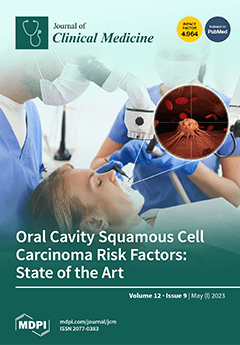Background: Vascular calcification is an ever-more-common finding in protocoled pre-transplant imaging in living kidney donors. We intended to explore whether a connection could be found between the Agatston calcification score, prior to kidney donation, and post-donation renal function. Methods: This is a retrospective
[...] Read more.
Background: Vascular calcification is an ever-more-common finding in protocoled pre-transplant imaging in living kidney donors. We intended to explore whether a connection could be found between the Agatston calcification score, prior to kidney donation, and post-donation renal function. Methods: This is a retrospective analysis of 156 living kidney donors who underwent living donor nephrectomy between January 2010 and December 2016. We quantified the total calcification score (TCaScore) by calculating the Agatston score for each vessel, abdominal aorta, common iliac, and renal arteries. Donors were placed into two different groups based on their TCaScore: <100 TCaScore group and ≥100 TCaScore group. The relationship between TCaScore, 1-year eGFR, proteinuria, and risk of 1 measurement of decreased renal function (eGFR < 60 mL/min/1.73 m
2) over 5 years of follow-up was investigated. Results: The ≥100 TCaScore group consisted of 29 (19%) donors, with a median (interquartile range) calcification score of 164 (117–358). This group was significantly older, 56.7 ± 6.9 vs. 45.5 ± 10.6 (
p < 0.001), had a higher average BMI (
p < 0.019), and had a lower preoperative eGFR (
p < 0.014). The 1-year eGFR was similarly diminished, 69.9 ± 15.7 vs. 76.3 ± 15.5 (
p < 0.048), while also having an increased risk of decreased renal function during the follow-up, 22% vs. 48% (
p < 0.007). Conclusions: Our study, through univariate analyses, found a relationship between a TCaScore > 100, lower 1-year eGFR, and decreased renal function in 5 years. However, a higher-than-expected vascular calcification should not be an excluding factor in donors, although they may require closer monitoring during follow-up.
Full article






